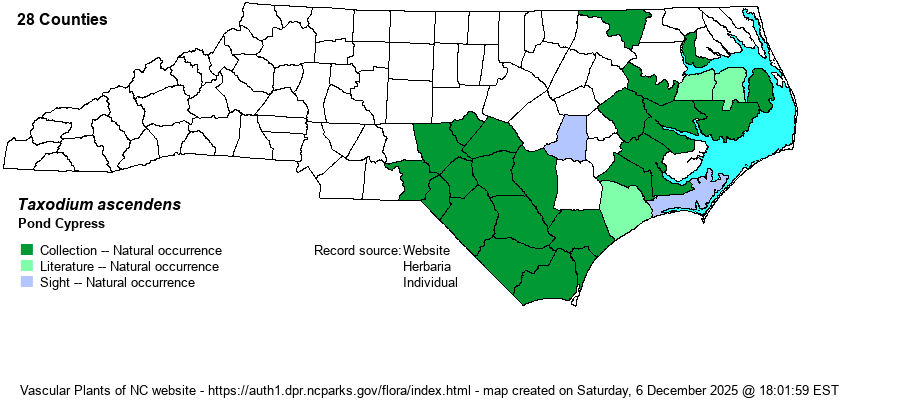| Author | Brongniart | |
| Distribution | Scattered over most of the Coastal Plain, but primarily found in the southern third (Harnett to Pender counties and southward); widely present north to Albemarle Sound, but hardly any records for counties along the VA border.
This Coastal Plain species ranges north to southeastern VA, and south to southern FL and LA. There are a few Piedmont reports from south and west of NC, perhaps incorrectly.
| |
| Abundance | Locally common in parts of the southern Coastal Plain, including the Sandhills, especially in Carolina bays, impoundments, and slow-moving or standing blackwater areas. Mostly uncommon and local in the northern two-thirds of the Coastal Plain. | |
| Habitat | This is a species of standing or slowly moving blackwater areas – Carolina bays, limesink ponds, impoundments and beaver ponds, wet pocosins, and portions of blackwater floodplains, mostly in backswamps. It can occur with the very similar Bald Cypress (T. distichum), though that species has a wider habitat range, to also include brownwater swamps and more flowing waters. Some trees along some blackwater rivers, such as lower Drowning Creek and Lumber River, possess leaf features of both taxa (Sorrie, pers. obs.) and will not key cleanly. |
| Phenology | Flowers in March and April; fruits in October. | |
| Identification | The two cypresses (Taxodium) can be easily confused, and many references consider them conspecific, though of separate varieties. This species is a small to often medium deciduous tree, usually reaching about 50 feet tall. (Note that the two cypress species are our only deciduous native conifers.) Both cypresses have wide buttresses, and often show exposed “knees” sticking out of the water; but this species has small, needle-like leaves that are appressed to the stem, such that the ends of the twigs are somewhat pencil-sized and often erect, with leaves hard to spot at any distance. (Bald Cypress has “feather-like” leaves in two ranks, though young branches and sprouts often have leaves as in Pond Cypress.) The key is that all leaves of Pond Cypress are appressed, whereas some to most (if not all) leaves of Bald Cypress are feather-like with flattened sprays. For identification, it is best to use leaves from the upper portion of the tree. Pond Cypress has smaller round cones (usually less than 1 inch across) and a paler color to the bark, but -– in reality -– you must carefully look at the leaves and needles. It is also advisable to look at a stand of trees, and not just a single tree, to be sure of identification. | |
| Taxonomic Comments | As mentioned above, seemingly half of the references still include both cypresses under one species as Bald Cypress, with this form being T. distichum var. imbricarium or as T. distichum var. nutans (but interestingly not as var. ascendens).
| |
| Other Common Name(s) | Often written as Pond-cypress, as these two species are not true cypresses (mostly in the genus Cupressus). | |
| State Rank | S4 | |
| Global Rank | G5 | |
| State Status | | |
| US Status | | |
| USACE-agcp | OBL link |
| USACE-emp | OBL link |

